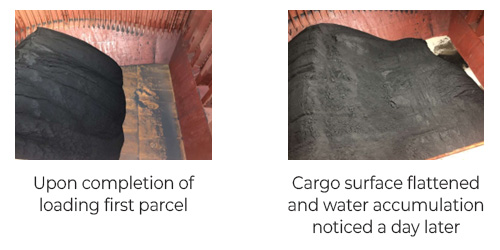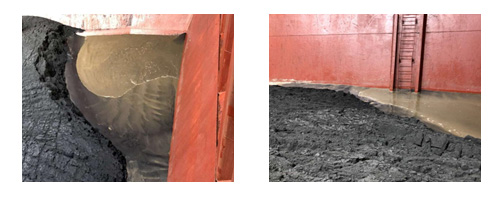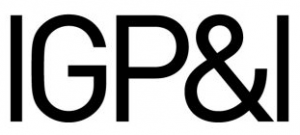Despite being categorized as a ‘Group C’ cargo in the International Maritime Solid Bulk Cargoes (IMSBC) Code, Gard’s recent experience in South Africa suggests that chromite ore may exhibit Group A properties including the potential to liquefy.

Liquefaction of chromite ore originating from South Africa
Published 14 August 2024
Cargo information did not match cargo loaded
The vessel had loaded a parcel of Chromite Ore at Durban in cargo hold no. 1 and proceeded to sea while waiting for subsequent parcels to be loaded. The cargo had been declared as Group C with no declared moisture content (MC) and transportable moisture limit (TML). While waiting for further cargo, the Master reported that the cargo was showing signs of liquefaction. Investigations revealed that the cargo was fine particles and had flow potential. Recent heavy rains likely contributed to the elevated moisture content in the stockpiles, which were exposed to the elements. The shippers provided an updated cargo declaration, where the name of the cargo was amended from “chromite ore” to “Chromite Ore (metallurgical grade concentrate)” and Documentation for MC and TML was provided as well, although the cargo was still declared as Group C. The vessel was subsequently detained by South African Maritime Safety Authority (SAMSA). The detention note stated “Cargo had shifted rendering the vessel unseaworthy, and cargo information provided before loading did not match the cargo loaded onboard”.

Incorrect IMSBC Group
The vessel loaded Chromite Ore at Durban and departed for Maputo. On arrival Maputo, it was noticed that there was a substantial amount of water collected in the corners of the stow in all cargo holds. The presence of muddy and liquefied cargo indicated that the cargo was Group A and not the Group C as was indicated on the shipper’s declaration.

Challenges
Cargo classification: According to the schedule in the IMSBC Code, designates chromite ore is a Group C cargo, and includes both chrome concentrates and lumpy ore. Chrome concentrates may exhibit Group A properties. IMSBC Appendix 3, Section 2.1, cargoes which are damp or wet and contain fine particles should be tested for flow characteristics “prior to loading” to verify whether the cargo is Group A. In our experience this is usually not done for various reasons, including shippers’ lack of familiarity with the IMSBC Code.
Characteristics of chromite ore concentrates: Experts have advised that stockpiles of chrome concentrate behave differently with respect to moisture compared to other concentrates. Chrome concentrates can absorb a significant amount of moisture if exposed to heavy rainfall. The moisture readily penetrates the piles during rain rather than running off, as with most other types of concentrate. Moisture also easily drains toward the base of the stockpiles which results in the bottom layer of cargo being much wetter than the accessible top surface. This means that the sampling method for stockpiles of concentrate as recommended in Section 4.6.3 of the Code i.e. samples to be drawn from 50cm depth across the surface of the pile, will not be suitable. A representative sampling method would need to take the specific drainage properties of this cargo into consideration, as also noted in Section 4.4.5.7 of the Code.
Loading multiple cargoes: Shippers may want to load multiple different mineral cargoes into the same hold. This makes trimming more difficult and increases the risk of cross contamination of mutually incompatible grades of mineral cargoes.
Recommendations
It is crucial to engage charterers in early discussions if your vessel is nominated to carry chromite ore, as a cargo declaration classifying it as Group C may not be accurate, as seen in the above examples. The cargo may appear to be dry and granular when shipped, however, it may be prone to liquefaction at a subsequent stage. Some signs to look for:
splatter on the bulkhead of the cargo holds,
failed can tests,
fine nature of chromite ore cargo,
recent rainfall in the port,
MC & TML certificates provided but cargo still declared as Group C. Refer to our topic page on liquefaction for further details.
The cargo surface should be trimmed completely flat on completion of loading to minimize the risk of the cargo shifting.
During the voyage, the crew should regularly check the condition of the cargo. Any sign of cargo liquefaction such as flattening, shifting, free surface water, or vessel instability be seen as a need for urgent assistance not limited to seeking safe anchorage.
In case of any doubt about the safety of the cargo or reliability of certificates, we encourage a low threshold for contacting the Club for assistance.
As a precautionary measure, Gard has geofenced this region in our systems so that our Members can be alerted if their vessel is calling South Africa for loading chromite ore.
We would like to thank Martin Jonas of Brookes Bell for his contribution to this alert.


